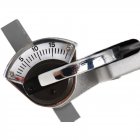I've had neck galling before from brass buildup in the neck portion of the die. In my case, it was caused by sizing new brass without first chamfering the outside of the case mouth. The square edge smeared along the inside of the die and left a tiny streak of brass behind. The next case added to it, and so on.
I also had a Forster full length sizing die with a poor surface finish in the shoulder junction.
With the first die, I used Brasso metal polish on a piece of cloth wrapped around a nylon cleaning brush chucked in a cordless drill. 5-10 minutes with that and the die surface was like a mirror again.
I don't use the Forster die any more, but the other one gets regular use.
In my experience, a dry, freshly cleaned die should have a very thin coat of sizing wax applied before you use it. Maybe coat a Q-tip with sizing lube and use that to lube the die. Otherwise, you're dealing with a dry, clean surface rubbing against a lubed one until the die gets a coating on it. That first case with a clean die takes noticeably more effort to size than the following ones.
All I use is the Lee sizing lube for about $7 per tube. I'm on my second tube in about 8 years, and have had zero problems with it.
I also had a Forster full length sizing die with a poor surface finish in the shoulder junction.
With the first die, I used Brasso metal polish on a piece of cloth wrapped around a nylon cleaning brush chucked in a cordless drill. 5-10 minutes with that and the die surface was like a mirror again.
I don't use the Forster die any more, but the other one gets regular use.
In my experience, a dry, freshly cleaned die should have a very thin coat of sizing wax applied before you use it. Maybe coat a Q-tip with sizing lube and use that to lube the die. Otherwise, you're dealing with a dry, clean surface rubbing against a lubed one until the die gets a coating on it. That first case with a clean die takes noticeably more effort to size than the following ones.
All I use is the Lee sizing lube for about $7 per tube. I'm on my second tube in about 8 years, and have had zero problems with it.











